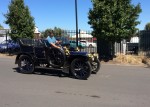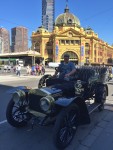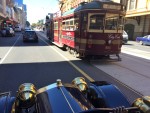Driving in Melbourne in a 1906 Vulcan Phaeton
Driving from the Melbourne Showgrounds in Flemington to Flinders Street station is normally a routine short trip. But when the vehicle is a 109 year old car it becomes a very special experience.

So when Adam Auditori asked me if I wanted to accompany him on a run into the city and back in his 1906 model Vulcan Phaeton, I jumped at the chance.
The car had been on display at the Australian Motoring Festival from 26 to 29 March. On the day after the festival closed, cars were being driven or trialered out and exhibits were being dismantled. I’d arrived to collect an auction item I’d bought on Sunday when I met Auditori and the Vulcan.
The car starts with one easy turn of the crank. Moving quickly through first and second gears and into top, the engine revs slowly and keeps up a chugging rhythm. The 20 horsepower, 3 litre 4-cylinder engine can generate a brisk 60 kph cruising speed without any trouble and once on the move can slow to walking pace and pull away again while still in top gear. Watch this short video taken in the Vulcan to experience some of the sound and feel of this auto veteran.

Past Flemington Racecourse to Flinders Street station and around the Treasury Gardens, the Vulcan gave Melbourne’s lunchtime school holiday crowds a rare treat. Phone cameras were everywhere. A fuel stop on our return journey gave a young boy, family car at the next petrol pump, the thrill of sitting up on the leather upholstered seats while his mum took a photo. They had come to Melbourne from Brisbane for the Cricket World Cup final, but this experience will probably be every bit as memorable as Australia’s cruising victory.
Those leather seats are amazingly comfortable. Filled with horse hair, they are like sitting on a moving chesterfield sofa and leg room is expansive to say the least. The front passenger seat lifts off to expose the fuel filler cap. The Vulcan runs on ordinary unleaded petrol, as it hails from an era before lead additive was even used. What was once modern is modern again.
Adam explains the driving technique as we continue the journey. The throttle is the middle of the three foot pedals. The foot brake connected to the rear wheels is supplementary to the parking brake lever, which is more effective to slow the car from cruising speed. Leaving a safe braking distance is assumed. No synchromesh, but most times the gears change without too much fuss. Even in some heavy stop-start traffic in the city, the car never stalls and there wasn’t any tell-tale steam shooting out of the pressure relief valve on the radiator cap.

The Vulcan Motor company was based in Southport, England and produced cars from 1902 until the late 1920s and continued to build commercial vehicles until 1953. As was the way in those days, the 1906 Phaeton has a coachbuilt body made by Woodheads of Southport. According to Auditori, very few Vulcans were imported into Australia and it takes a discerning eye to identify this one. There wasn’t much branding on very early cars and in this case the name Vulcan appears on the wheel hubs.
All too soon we were back at the showgrounds. The journey back in time was finished but the experience will linger.
After the drive, it occurred to me that the reactions of people seeing the Vulcan Phaeton driving through the middle of Melbourne in 2015 may not have been much different to those who saw a similar sight back in 1906.
You can click here to check out more photographs of the Vulcan in the Car Cavalcade photo gallery.
And click here for the Car Cavalcade photo gallery from the Australian Motoring Festival.